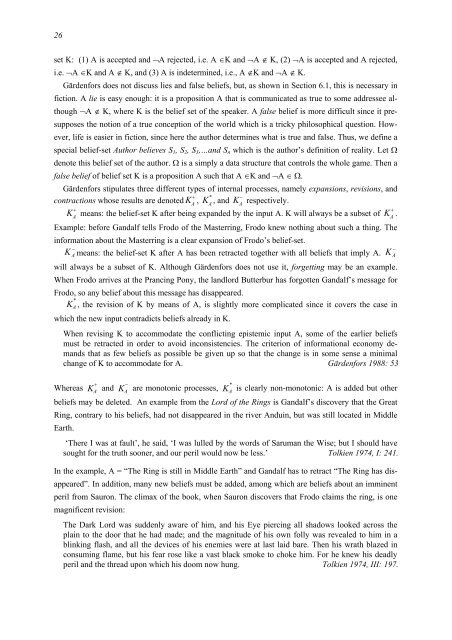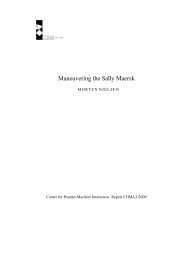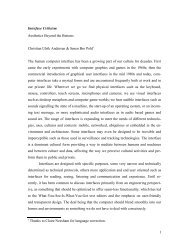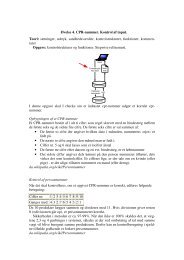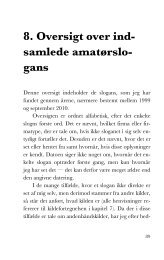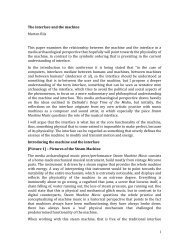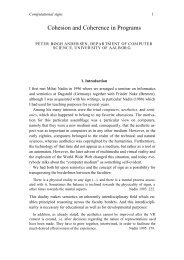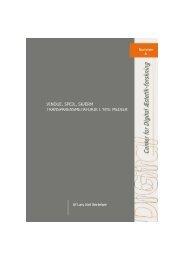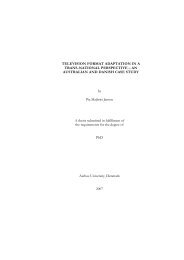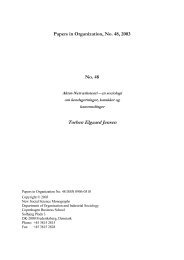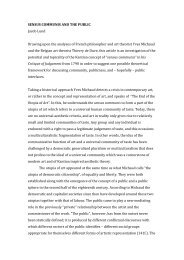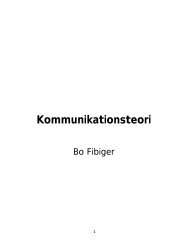Interaction and narration. Tearing Tolkien apart - CiteSeerX
Interaction and narration. Tearing Tolkien apart - CiteSeerX
Interaction and narration. Tearing Tolkien apart - CiteSeerX
You also want an ePaper? Increase the reach of your titles
YUMPU automatically turns print PDFs into web optimized ePapers that Google loves.
26<br />
set K: (1) A is accepted <strong>and</strong> ¬A rejected, i.e. A ∈K <strong>and</strong> ¬A ∉ K, (2) ¬A is accepted <strong>and</strong> A rejected,<br />
i.e. ¬A ∈K <strong>and</strong> A ∉ K, <strong>and</strong> (3) A is indetermined, i.e., A ∉K <strong>and</strong> ¬A ∉ K.<br />
Gärdenfors does not discuss lies <strong>and</strong> false beliefs, but, as shown in Section 6.1, this is necessary in<br />
fiction. A lie is easy enough: it is a proposition A that is communicated as true to some addressee although<br />
¬A ∉ K, where K is the belief set of the speaker. A false belief is more difficult since it presupposes<br />
the notion of a true conception of the world which is a tricky philosophical question. However,<br />
life is easier in fiction, since here the author determines what is true <strong>and</strong> false. Thus, we define a<br />
special belief-set Author believes S 1 , S 2 , S 3 ,…<strong>and</strong> S n which is the author’s definition of reality. Let Ω<br />
denote this belief set of the author. Ω is a simply a data structure that controls the whole game. Then a<br />
false belief of belief set K is a proposition A such that A ∈K <strong>and</strong> ¬A ∈ Ω.<br />
Gärdenfors stipulates three different types of internal processes, namely expansions, revisions, <strong>and</strong><br />
+ *<br />
−<br />
contractions whose results are denoted K A<br />
, K A<br />
, <strong>and</strong> K A<br />
respectively.<br />
K A<br />
+<br />
means: the belief-set K after being exp<strong>and</strong>ed by the input A. K will always be a subset of .<br />
Example: before G<strong>and</strong>alf tells Frodo of the Masterring, Frodo knew nothing about such a thing. The<br />
information about the Masterring is a clear expansion of Frodo’s belief-set.<br />
K means: the belief-set K after A has been retracted together with all beliefs that imply A.<br />
−<br />
A<br />
will always be a subset of K. Although Gärdenfors does not use it, forgetting may be an example.<br />
When Frodo arrives at the Prancing Pony, the l<strong>and</strong>lord Butterbur has forgotten G<strong>and</strong>alf’s message for<br />
Frodo, so any belief about this message has disappeared.<br />
*<br />
K A , the revision of K by means of A, is slightly more complicated since it covers the case in<br />
which the new input contradicts beliefs already in K.<br />
When revising K to accommodate the conflicting epistemic input A, some of the earlier beliefs<br />
must be retracted in order to avoid inconsistencies. The criterion of informational economy dem<strong>and</strong>s<br />
that as few beliefs as possible be given up so that the change is in some sense a minimal<br />
change of K to accommodate for A. Gärdenfors 1988: 53<br />
Whereas <strong>and</strong> are monotonic processes, is clearly non-monotonic: A is added but other<br />
beliefs may be deleted. An example from the Lord of the Rings is G<strong>and</strong>alf’s discovery that the Great<br />
Ring, contrary to his beliefs, had not disappeared in the river Anduin, but was still located in Middle<br />
Earth.<br />
K A<br />
+<br />
K A<br />
−<br />
K A<br />
*<br />
‘There I was at fault’, he said, ‘I was lulled by the words of Saruman the Wise; but I should have<br />
sought for the truth sooner, <strong>and</strong> our peril would now be less.’ <strong>Tolkien</strong> 1974, I: 241.<br />
In the example, A = “The Ring is still in Middle Earth” <strong>and</strong> G<strong>and</strong>alf has to retract “The Ring has disappeared”.<br />
In addition, many new beliefs must be added, among which are beliefs about an imminent<br />
peril from Sauron. The climax of the book, when Sauron discovers that Frodo claims the ring, is one<br />
magnificent revision:<br />
The Dark Lord was suddenly aware of him, <strong>and</strong> his Eye piercing all shadows looked across the<br />
plain to the door that he had made; <strong>and</strong> the magnitude of his own folly was revealed to him in a<br />
blinking flash, <strong>and</strong> all the devices of his enemies were at last laid bare. Then his wrath blazed in<br />
consuming flame, but his fear rose like a vast black smoke to choke him. For he knew his deadly<br />
peril <strong>and</strong> the thread upon which his doom now hung. <strong>Tolkien</strong> 1974, III: 197.<br />
K A<br />
+<br />
−<br />
K A


